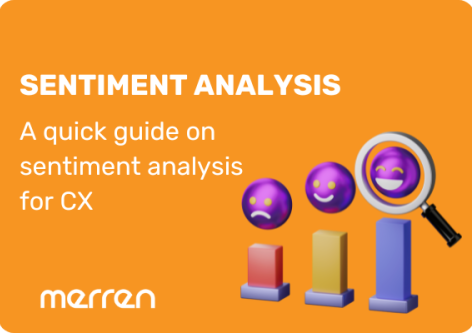The virtual network has made it difficult to determine how people really feel offline. However, human emotions can determine the success of most purchases. To identify how people feel during transactions and post-purchase, CX professionals rely on sentiment analysis obtained from customer satisfaction metrics. Customer satisfaction metrics can determine if people are happy, unhappy or indifferent to products, services or experiences. In this blog, we will understand how sentiment analysis is a critical part of customer experience.
What is Customer Sentiment?
Customer sentiment (or customer emotion) is the opinion of customers on products, services or experiences across touchpoints in a customer journey . Analyzing customer sentiment is known as sentiment analysis.
Customer sentiment analysis in CX
Customer Sentiment analysis is an AI-powered process that collects qualitative and quantitative data to identify emotional tone and classify feedback into positive, neutral, or negative categories. It uses natural language processing (NLP) and machine learning to break feedback into topics (e.g. product features vs. service quality) or combining text, audio, and visual data.
Customer sentiment analysis can be applied to various forms of feedback including social media posts, product reviews, customer feedback surveys, news articles, and more.
How Sentiment Analysis Works
- Data collection: Compile customer feedback from surveys, review sites, support logs, chatbots, and social media.
- Text, voice & visual processing: Use NLP for text, speech‑to‑text for voice notes, and image/video analysis for multimodal sentiment detection.
- Sentiment classification: Classify sentiment as positive, neutral, or negative or more granular levels like “very positive” vs “slightly negative”.
- Aspect-based sentiment: Break feedback into components such as feedback from delivery, support, product quality and assign sentiment to each for detailed insight.
- CX dashboard & visualization: Display insights via dashboards: sentiment trends over time, word clouds, sentiment scores, and topic breakdowns for stakeholders and teams.
Why Customer Sentiment and Sentiment Analysis Matter
Customer sentiment analysis provides ‘emotional’ insights into how people feel about a particular subject, product, service, or brand. Here are some key reasons why sentiment analysis is crucial:
1. Reveals the why behind a behavior:
Surveys are the first step to collect in-moment responses. Customer sentiment reveals the emotional metrics behind the responses. Metrics such as conversion rate, churn rate, retention rate, onboarding experience uncovers emotional drivers behind customer actions.
2. Assess brand reputation on social media:
Monitoring online customer sentiment tells companies what people ‘think’ of their brand. Track positive and negative mentions and address potential issues promptly. In this manner, companies can close the feedback loop and maintain a positive brand image.
3. Assess customer and competitor behavior:
Customer sentiment analysis can be used to analyze market trends and competitor performance. Use the data to understand how customers perceive competitors. Businesses can identify strengths and weaknesses, adjust their strategies, and gain a competitive edge.
4. Proactive experience management:
During a crisis or PR issue, customer sentiment analysis can help organizations assess the impact of the situation on public opinion. Real-time sentiment analytics allow brands to detect and resolve issues before escalation like turning detractors into advocates within hours. This is especially useful when a brand’s decision has a greater impact on their consumers.

Types of Customer Sentiment Analysis
Sentiment analysis can be performed at different levels each offering unique insights and applications. The main types of customer sentiment analysis are as follows:
1. Document-level sentiment analysis:
Document-level analyses the overall sentiment of an entire document or piece of text. It provides a high-level overview of the sentiment expressed in the text (such as a survey response). This is useful for summarizing lengthy documents, such as articles or reports.
2. Sentence-level sentiment analysis:
Sentence-level sentiment analysis will assess the sentiment of individual sentences within a document. This approach provides more granular insights. This method will comprehend the emotions expressed in specific parts of the text, such as customer reviews or social media posts.
3. Aspect-based sentiment analysis:
Aspect-based sentiment analysis goes a step further. It identifies specific aspects or features mentioned in the text and gauges the sentiment associated with each aspect. For example, in a product review, aspect-based sentiment analysis can identify emotions related to features like quality, price, and usability.
4. Emotion detection:
Emotion detection will identify specific emotions expressed in the text: happiness, anger/ frustration, sadness, or delight. This type of analysis can be particularly useful for applications like customer support and mental health monitoring.
5. Intent analysis:
Intent analysis focuses on identifying the underlying intent or purpose behind a piece of text. For example, it can determine whether a customer review is meant to provide feedback, ask for support, or make a complaint. Understanding intent helps businesses respond appropriately to customer needs and improve their services.

How Does CX Benefit from Customer Sentiment Analysis?
Customer experience is the sum of brand reputation, customer experiences from across platforms, touchpoints, and channels. These insights empower CX teams to enhance satisfaction, build loyalty, and stay ahead of market demands. Here are the key ways CX leaders benefit from sentiment analysis:
1. Deliver better customer experience:
Customer sentiment data helps brands design experiences that truly resonate. Whether it’s refining a product feature or redesigning the support journey, companies can tailor offerings to match customer expectations. This leads to improved customer satisfaction, loyalty, and retention.
2. Make smarter data-driven decisions:
Sentiment analysis transforms unstructured feedback into real-time, actionable insights. CX professionals can leverage these insights to fine-tune messaging, optimize touchpoints, and make evidence-backed decisions that improve both marketing effectiveness and service delivery.
3. Close the feedback loop:
Identify negative customer sentiment early through surveys, social media, or chat logs. Using this information, brands can close the feedback loop faster. Support teams can intervene before dissatisfaction escalates, turning frustrated customers into retained ones and protecting brand reputation.
4. Gain a competitive advantage:
Monitoring sentiment toward competitors provides valuable market intelligence. Businesses can identify what customers love or dislike about rival brands and use those insights to fill market gaps, refine positioning, or create more compelling offerings.
5. Drive personalized marketing:
Sentiment data reveals what truly matters to each customer segment. Brands can use these emotional cues to deliver highly personalized messages, product recommendations, and experiences. People are more likely to respond to personalized service and product offerings.
6. Improve product development:
Product development teams can take public feedback to enhance an existing product. Product teams can use this feedback to iterate and innovate. Address pain points, enhance usability, and ensure new features align with real customer needs.
7. Optimize resources with automation:
Customer sentiment analysis automates the labor-intensive task of manually reviewing customer feedback. This frees up CX teams to focus on strategic initiatives, while missing no emotional signals regardless of the feedback volume.

Challenges and Considerations
While analysing sentiments from customer feedback has many benefits, one must acknowledge the challenges and considerations involved:
1. Language and context:
Algorithms may struggle with understanding context, sarcasm, and nuances in language. Accurately interpreting human emotions requires sophisticated NLP models that can handle diverse linguistic variations.
2. Data quality:
The accuracy of analysis depends on the quality and representativeness of the data. Biased or incomplete data can lead to incorrect sentiment predictions and flawed insights.
3. Domain-specific models:
Sentiment analysis models need to be trained on domain-specific data to achieve high accuracy. Generalized models may not perform well across different industries or applications.
4. Cultural differences:
Sentiment expressions can vary significantly across cultures and languages. Adapting sentiment analysis models to different cultural contexts is crucial for accurate sentiment interpretation.
5. Privacy and ethical concerns:
Sentiment analysis involves processing large amounts of personal data. It is essential to handle data ethically, ensuring privacy and compliance with relevant regulations.
Deploying Merren for Sentiment-Driven CX
With the Merren CX platform, you can harness all the capabilities above:
- Multichannel feedback processing: including surveys, voice notes, videos, and images
- AI‑powered NLP: Convert unstructured feedback to sentiment scores and theme categories automatically
- Sentiment dashboards: Real‑time visualization, word clouds, topic breakdowns, and trend tracking
- Reporting and automation: One‑click survey reports, alerting systems, and data integrations to respond rapidly
Get started with Merren, an AI-powered CX platform
- Choose your survey channels: surveys, social media, reviews, chat logs, voice or video.
- Implement sentiment analysis using Merren’s AI-powered real-time tracking and feedback engine.
- Visualize via dashboards: track sentiment over time, by theme, by demographic.
- Act on findings: address negative themes promptly; elevate positive sentiment.
- Benchmark and iterate: compare across time or cohorts to measure impact.
Conclusion
Human emotions are an integral part of customer experience. The best way to identify customer needs is to analyze sentiments and emotional metrics. CX marketers can deploy qualitative and quantitative feedback surveys. This can grasp people’s responses based on their experiences. While human experiences cannot simply be measured numerically. This is where sentiment analysis comes in for an in-depth research on how people feel in the ecosystem. Emotions drive purchase decisions. To create your own market research templates, sign up for a 14 day free trial with Merren.
